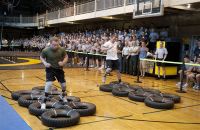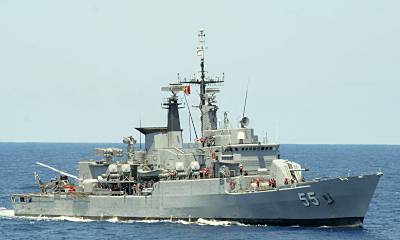WEST POINT, N.Y. — They run road races and compete in triathlons. They climb mountains, kayak through rapids and ski on snow and water.
They are America’s wounded warriors — veterans who continue to inspire by their resilience and will to overcome any obstacle placed before them.
Six Army soldiers and one Marine from Walter Reed Army Medical Center in Washington, D.C., visited the U.S. Military Academy here Sept. 10 to test their abilities on a challenging set of obstacles.
The indoor obstacle course test is a rite of passage for all West Point cadets as a testament to their physical fortitude. Being able to make it through this intense test of balance, strength and stamina is hard enough, given months of practice and training. But for the wounded warriors, with only hours of preparation, the test was an inspirational example of the Warrior Ethos and human perseverance, said Army Col. Gregory L. Daniels, the chief of the academy’s physical education department.
“These outstanding soldiers are a testament to the amazing power of the human spirit,” Daniels said of the wounded warriors. “They make no excuses for their so-called disabilities, and they drive on with an indomitable grit that is truly remarkable. Every single cadet should take notice and emulate their invincible spirit.”
For that reason, Daniels made sure cadets were present for this event. Hayes Gymnasium roared with the encouraging cheers of cadets as the wounded warriors moved through the timed course.
“I wanted the cadets to cheer them on with all their might and to be inspired by what they observed,” Daniels said. “These soldiers demonstrated the Warrior Ethos in a very unique and powerful way. I wanted as many cadets as possible to see first-hand the type of young person they will eventually have the immense responsibility and awesome privilege to lead.”
Cadets lined up to congratulate and speak with the group after the test. Cadet Brittany O’Connell said she left with a lump in her throat from what she’d witnessed.
“It made me realize that even with things as hectic as they are here, your problems may not be as big as you think they are,” she said. “It was truly amazing.”
When Daniels told the cadets to remember this event the next time they complained about something being too hard, Cadet Tom Snukis took it to heart.
“It was definitely inspiring, because you see cadets struggle through this every day,” said Snukis, who will take the course for score in October. “Then to come out here and see soldiers missing arms and legs, and they destroyed the [course]. ‘Inspiring’ is definitely the word.”
As the sole Marine and only double amputee in the group, Lance Cpl. Joshua Wege said he had even more to prove than his colleagues. He was not expecting such a large audience, he said, but it fueled his performance with an added dose of adrenaline.
“The entire bleachers were filled, and just the sound reverberating off the walls was cool,” Wege said. “I’ve never had crowds cheer me before. I was nervous at the starting line, which I don’t get very often, but with everyone watching and the blood pumping, I wanted to do the best I could.”
Army Spc. Matthew Kinsey said the group of wounded warriors is pretty close-knit, and it was evident in the way, as professional soldiers, they supported each other. They’d been practicing for a few weeks on a smaller course at Walter Reed, Kinsey said, but the West Point course was exhausting.
“At half-speed, the individual obstacles are not bad, but when you go through everything at once, that’s a challenge,” Kinsey said.
Along with Wege and Kinsey, Army Sgt. Robert Brown, Army Pvt. Harrison Ruzicka, Army Spc. Joshua Rector, Army Spc. Nicholas Edinger and Army Sgt. Shane Baldwin also participated.
Source:
U.S. Department of Defense
Office of the Assistant Secretary of Defense (Public Affairs)

 von
von 
